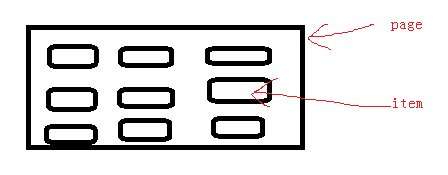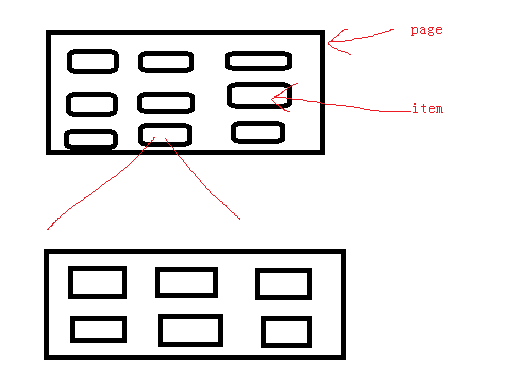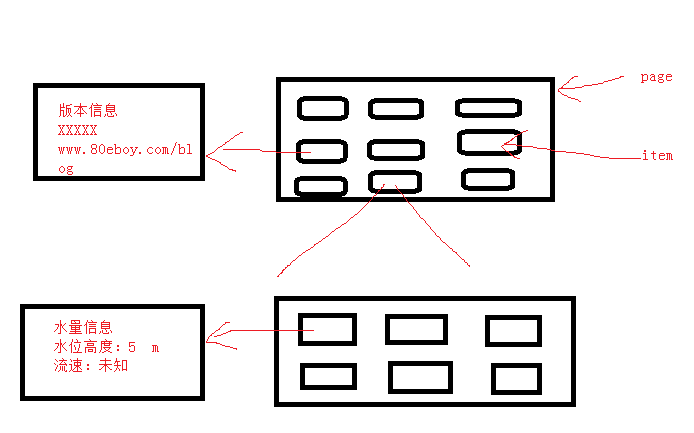相信很多攻城狮都用过液晶屏,想写好一点的ui好像不太可能或且花费很多时间,直接写吧,感觉好像很零碎,coding都怕了。
下面介绍一个简单易用的菜单框架,你会发现它能做多层菜单而且结果清晰。
基本原理: 
如上图液晶显示一屏我们定义为一个page,page中的项目定义为item;这样page就是item的容器了。当我们选中其中的一个item进去后是不是又是一个page呢,如下图。 
这样的话每一个item的下面都对应一个page,这样是不是就构成一个多层的菜单了。
他们是什么关系呢?
一个page中有item,那么用结构体就可以实现啦;item下面又有page,那么在item中加一个page的指针指向item对应的page页。
前面都是从上到下的,那么怎么返回呢?
观察发现返回就是子page返回父page,这样在page结构体中假如一项父page的指针不就ok了。
具体实现请看源文件。
/******************************************************************************************************/
//主菜单
//定义Item项 //显示方式&序号 项目的名字 项目指向的页(Page)
const struct Item main_item[]={ 0x00, "信息", &SMS_Page,
0x01, "设置", &Setting_Page,
0x02, "版本", &Version_Page,
0x03, "时间", &Time_Page,
0x04, "状态", 0,
0x05, "报警", 0,
0x06, "飞信", 0,
0x07, "问答", 0
};
//定义一个Page 父页 该页的回调函数 该页的项 项的个数
const struct PAGE mainPage={0,mainPageCallBack,main_item,sizeof(main_item)/sizeof(struct Item)};
/*********************************************************************************************************/
const struct PAGE Version_Page={&mainPage,Version_CallBack,0,0};
/***************************************************************************************************************/
//定义Item项 //显示方式&序号 项目的名字 项目指向的页(Page)
const struct Item Setting_item[]={ 0x10, " 00.设0", 0,
0x11, " 01.设1", 0,
0x12, " 02.设2", 0,
0x13, " 03.设3", 0,
0x14, " 04.设4", 0,
0x15, " 05.设5", 0,
0x16, " 06.设6 你好", 0,
0x17, " 07.设7", 0,
0x18, " 08.设8", 0,
0x19, " 09.设9", 0,
0x1A, " 10.设10", 0
};
const struct PAGE Setting_Page={&mainPage,Setting_CallBack,Setting_item,sizeof(Setting_item)/sizeof(struct Item)};
/***************************************************************************************************************/
const struct PAGE Time_Page={&mainPage,Time_CallBack,0,0};
/***************************************************************************************************************/
//定义Item项 //显示方式&序号 项目的名字 项目指向的页(Page)
const struct Item SMS_item[]={
0x10, " 00.", &SMS_Text_Page,
0x11, " 01.", &SMS_Text_Page,
0x12, " 02.", &SMS_Text_Page,
0x13, " 03.", &SMS_Text_Page,
0x14, " 04.", &SMS_Text_Page,
0x15, " 05.", &SMS_Text_Page,
0x16, " 06.", &SMS_Text_Page,
0x17, " 07.", &SMS_Text_Page,
0x18, " 08.", &SMS_Text_Page,
0x19, " 09.", &SMS_Text_Page,
0x1A, " 10.", &SMS_Text_Page
};
const struct PAGE SMS_Page={&mainPage,SMS_CallBack,SMS_item,sizeof(Setting_item)/sizeof(struct Item)};
Menu.h:
#ifndef _Menu_H_BAB #define _Menu_H_BAB #include "stm32f10x.h" #include "LCD.h" #include "Key.h" #define KEY_Special 255 ///<这个保留用于特别事件 //菜单调试,在调试时最好定义,可以帮助发现问题;当发布时把其置为0可以加快速度 #define MENU_DEBUG 1 void Menu_Show(void); struct PAGE { const struct PAGE *pParent; void (*Function)(u8 key); const struct Item *pItem; const u8 ItemNum; }; struct Item { /** 高4位作为特殊用途(bit4=1表示列表显示否则两列显示),低4位用于标记Item的序号 如果为列表模式时*pText的格式为:" xx.string",最前面保留一个空格用于个光标(>)使用,xx.为两位序号不要"."一定要有,string是要显示的文字,最多能显示6个汉字 如果是两列显示则pText,即为要显示的文本(最多2个汉字) */ const u8 TypeAndIndex; const u8 *pText; const struct PAGE *pChildrenPage; }; extern const struct PAGE *pPage; void SetMainPage(const struct PAGE *pMainPage); void ShowMenu(const struct PAGE *pPage); void ShowPage(const struct PAGE *pPage); void ShowParentPage(void); void ShowItemPage(void); void SelPageItem(u8 ItemIndex); u8 Menu_GetSelItem(void); void GetShowLst(u8 *pOutMin,u8 *pOutMax); void KeySelItem(u8 key); #endif
Menu.c:
#include "Menu.h" //保存选中的菜单项变量 static u8 SelItem=0; /** 用于当前LCD列表中显示着哪几项 高4位:最大序号 低4为:最小序号 */ static u8 ListShow=0x00; const struct PAGE *pPage; void SelItemOfList(u8 index); void SetMainPage(const struct PAGE *pMainPage) { pPage=pMainPage; } /** 获得当前选中的菜单项 @return 返回菜单序号 */ u8 Menu_GetSelItem(void) { return SelItem; } /** 获取当前显示列表的范围 @param pOutMin 当前显示的最小序号 @param pOutMax 当前显示的最大序号 */ void GetShowLst(u8 *pOutMin,u8 *pOutMax) { *pOutMin=ListShow&0x0f; *pOutMax=ListShow>>4; } void ShowList(u8 min,u8 max) { u8 i=0,index=0; #if MENU_DEBUG if(max-min>3) { Lcd_Clr_Scr(); LCD_Write_Str(0,0,"err:ShowList>3"); while (1); } if ((pPage->pItem[0].TypeAndIndex & 0x10)==0)///<如果是使用列表方式 { Lcd_Clr_Scr(); LCD_Write_Str(0,0,"不是列表类型不能不能列出"); while (1); } #endif Lcd_Clr_Scr(); for (index=min;index<=max;index++) { LCD_Write_Str(i++,0,pPage->pItem[index].pText); } ListShow=(max<<4)|min; ///<记录当前显示的Item } /** 页显示 1.当这个页有项目(Item)时:显示Item并同时选中Item 0 2.没有时:会调用该Page的回调函数并传入KEY_Special 参数 @param pPage 指向一个page */ void ShowPage( const struct PAGE *pPage) { s8 i; ///清屏 Lcd_Clr_Scr(); if(pPage->pItem==0) { pPage->Function(KEY_Special); return; ///<如果没有Item项则不显示Item,直接返回 } if (pPage->pItem[0].TypeAndIndex & 0x10)///<如果是使用列表方式 { ShowList(0,3); SelItemOfList(0); pPage->Function(KEY_Special); } else { ///取出page中的Item并显示 for (i=0;iItemNum;i++) { if (i<4) { LCD_Write_Str(i,1,pPage->pItem[i].pText); } else { LCD_Write_Str(i-4,5,pPage->pItem[i].pText); } } SelPageItem(0);///<选中Item 0 pPage->Function(KEY_Special); } }; /** 显示父页(ParentPage) */ void ShowParentPage(void) { pPage=pPage->pParent; ShowPage(pPage); } /** 显示项目(Item)下对应的页(Page) */ void ShowItemPage(void) { //如果该项下没有页,这警告或返回 if (pPage->pItem[Menu_GetSelItem()].pChildrenPage ==0) { #if MENU_DEBUG Lcd_Clr_Scr(); LCD_Write_Str(0,0,"该项下无显示请修正"); while (1); #else return; #endif } pPage=pPage->pItem[Menu_GetSelItem()].pChildrenPage; //获得菜单项(Item)对应的page ShowPage(pPage); } /** 选择page中的Item项 @param ItemIndex page中Item的索引号 0~7 */ void SelPageItem(u8 ItemIndex) { ///检查是否有错误调用 #if MENU_DEBUG if (ItemIndex>=8) { LCD_Write_Str(0,0,"设置菜单项溢出"); return; } #endif ///清除上次选中的 if (SelItem<4) { LCD_Write_Str(SelItem,0," "); LCD_Write_Str(SelItem,3," "); } else { LCD_Write_Str(SelItem-4,4," "); LCD_Write_Str(SelItem-4,7," "); } ///选中这次要选中的 if (ItemIndex<4) { LCD_Write_Str(ItemIndex,0,"【"); LCD_Write_Str(ItemIndex,3,"】"); SelItem=ItemIndex; } else { LCD_Write_Str(ItemIndex-4,4,"【"); LCD_Write_Str(ItemIndex-4,7,"】"); SelItem=ItemIndex; } }; void SelItemOfList(u8 index) { u8 max; u8 min; max=ListShow>>4; min=ListShow&0x0f; if (index>max) ///<超出最大当前显示的序号 { LCD_Write_Str(Menu_GetSelItem()-min,0," "); min+=1; max+=1; ShowList(min,max); ListShow=(max<<4)|min; LCD_Write_Str(index-min,0,">"); } else if(index>=min)///<在最小和最大序号之间 { LCD_Write_Str(Menu_GetSelItem()-min,0," "); LCD_Write_Str(index-min,0,">"); } else ///<低于最小当前显示最小序号 { LCD_Write_Str(Menu_GetSelItem()-min,0," "); min-=1; max-=1; ShowList(min,max); ListShow=(max<<4)|min; LCD_Write_Str(index-min,0,">"); } SelItem=index; } void KeySelItem(u8 key) { s8 index; if (pPage->pItem[0].TypeAndIndex & 0x10)///<如果是使用列表方式 { switch(key) { case KEY_UP: index=Menu_GetSelItem()-1; if(index<0) break; SelItemOfList(index); break; case KEY_Down: index=Menu_GetSelItem()+1; if(index>(pPage->ItemNum-1)) break;; SelItemOfList(index); break; } return; } switch(key) { case KEY_UP: index=Menu_GetSelItem()-1; if(index<0) index=pPage->ItemNum-1; SelPageItem(index); break; case KEY_Down: index=Menu_GetSelItem()+1; if(index>(pPage->ItemNum-1)) index=0; SelPageItem(index); break; case KEY_Left: case KEY_Right: index=Menu_GetSelItem(); if (index<4) { if((index+4)>(pPage->ItemNum-1)) return; //右没有Item项,无法选中右边项;所以返回 index+=4; //右边有Item时把index定位到右边的Item } else index-=4; //因为右边有Item项时,左边一定有Item项;因为是按顺序安排的 SelPageItem(index); break; } }
篇幅有限,MenuAPP代码未贴出。
审核编辑:汤梓红
-
液晶
+关注
关注
6文章
606浏览量
69648 -
STM32
+关注
关注
2270文章
10904浏览量
356326 -
液晶屏
+关注
关注
18文章
719浏览量
42871 -
指针
+关注
关注
1文章
480浏览量
70573
原文标题:一个STM32菜单框架,文末附工程文件
文章出处:【微信号:c-stm32,微信公众号:STM32嵌入式开发】欢迎添加关注!文章转载请注明出处。
发布评论请先 登录
相关推荐
12864液晶使用教程分享 基于MCU菜单框架设计方案

STM32简易多级菜单(数组查表法)显示方法

如何设计一个产品级MCU菜单框架
单片机实例:一个用单色屏做的菜单框架资料下载

一个产品级MCU菜单框架设计~

基于STM32F407的简易菜单设计+LCD+按键

基于LCD驱动架构的MCU菜单框架设计





 分享一个STM32菜单框架
分享一个STM32菜单框架












评论